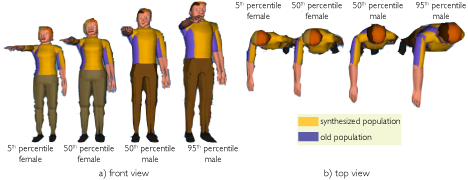Digital Human Models are used extensively in virtual manufacturing to evaluate hand clearance and reach. Spatial assessments of accommodation are typically conducted using digital human models representative of the manufacturing population. Unfortunately, these models are often based on anthropometry gathered from sources that are not representative of the actual target worker population. For example, the size and shape might be based on data from the U.S. military, which differs in fitness, age, and race distributions from the typical automotive manufacturing population. Ford ergonomists traced errors in accommodation predictions to these inaccurate representations. Using a recently developed statistical methodology incorporating principal components analysis, the anthropometry of the target worker population was synthesized. Using these new data, Ford updated the anthropometry of their digital human models to reflect changes due to secular trends in the U.S. The models also consider the diversity in age and race, thus producing Ford manikins that better represent the variability in their worker base. The improved ability to accurately predict accommodation allows for significant immediate and long-term reductions in engineering costs.

